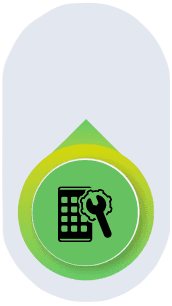Empower DeFi with NFTs – The Future of Digital Finance

What is NFTs in DeFi ?
DeFi provides a fundamental restructuring of the financial system by eliminating intermediaries and allows for direct transactions. Now, the use of non-fungible tokens (NFTs) is providing the next leap into DeFi, with unique features like uniqueness, proof of ownership, and liquidity for digital assets.
NFT-based DeFi solutions allow users to:
- Offer NFTs as collateral for loans
- Earn passive income via NFT staking
- Tokenize real-world assets for fractional ownership
- Insure digital assets from unforeseen risks
This convergence of NFTs into DeFi creates opportunities for the emergence of a more inclusive, secure, and scalable financial ecosystem.
Key NFT Use Cases in DeFi Solutions
With NFTs’ ability to reflect the marketing of digital products and services, the NFT decentralized finance combination becomes instantly possible. NFTs have emerged as one of the most promising DeFi applications.
NFT-Based Lending & Borrowing.
Users are now NFT-collateral-backed borrowing against crypto loans, allowing them to liquidity access without losing their valuable digital assets. Such models can protect assets while also providing a path to innovative financial ventures in the future.


NFT Staking and Yield Farming.
NFT staking allows users to lock their NFT in smart contracts to earn some rewards. Meanwhile, yield farming will increase its benefits of it by offering passive income opportunities in the ecosystem of DeFi.
Asset Tokenization and Fractional Ownership.
Tokenization provides a mechanism that allows the representation of high-value physical assets- almost real estate, art, and luxury assets as enabling investors to gain fractional shares of these assets and democratizing access to wealth building.


NFT Insurance in DeFi.
DeFi is certainly a high-context world where people need to be secure. So, NFT-based insurance products are evolving around providing protection against hacking, fraud, and market fluctuations, providing safer investments from the end-user perspective.
Our NFT DeFi Development Services
Smart Contract Development
Secure, automated, and efficient smart contracts for NFT-based DeFi services.
NFT Marketplace Integration
Seamless NFT trading with built-in DeFi functionalities.
Liquidity Pool Development
Enhance market efficiency with NFT-backed liquidity pools.
Cross-Chain NFT Integration
Multi-chain NFT support for greater accessibility.
Custom DeFi Wallets
Secure NFT storage and transactions with advanced wallet solutions.
Let’s Build a New Decentralized Future Together – Meet our CTO Now!
Why choose us for NFTs DeFi Development Services
The team is dedicated to providing high-performance, innovative, and secure NFT-DeFi solutions for businesses and investors.
Proficient Blockchain Developers
Adept at NFT and DeFi technologies.
Security-First Approach
Smart contract auditing and risk mitigation.
Scalable & Equipped for Future Growth
Future-ready solutions that serve perfectly long-term.
Cross-chain & Multi-platform Verified
Compatibilities include Ethereum, Binance Smart Chain, Solana, and others.
Our Development Approach

Strategy






Analysis
and
Planning

UI UX
Designing

App
Development

Testing

Deployment
and
Support



Analysis
and
Planning


UI UX
Designing


App
Development


Testing


Deployment
and
Support
Our Technology Development Stack



















Frequently Asked Questions
NFTs in DeFi are used as collateral for loans, staking assets, and making investments. Unlike other assets, they allow for fractional ownership and tokenization of real-world assets as well as secured lending and borrowing in the decentralized finance ecosystem.
NFT lending entails using one’s NFT collateral to borrow either a cryptocurrency or stablecoin. If the borrower pays back the loan, they keep their NFT; if they don’t, the lender gains the right to claim the NFT back in settlement.
Absolutely! By staking their NFTs and yield farming, users lock their NFTs into smart contracts, earning rewards, governance tokens, or interest for their staking, thereby passively increasing their income.
Asset tokenization refers to the process of constructing an NFT out of a physical or digital asset that allows users to buy, sell, or own fractional bits of valuable assets such as real estate, artwork, and collectibles on the DeFi platform.
NFT insurance is important to protect against risks from hacks, theft, and market volatility and compensates the users in case of any asset loss or any unforeseen events that may happen during DeFi transactions.
Prominent blockchains for NFT-DeFi solutions include Ethereum, Binance Smart Chain (BSC), Solana, Polygon, Avalanche, and Flow, depending mainly on applicability and voila-fe and other ecosystem compatibility criteria.
The security of NFT-DeFi rests on smart contract audit reports, decentralized governance, and risk management protocols, specifically to identify and avoid fraud, and hacks an act of malicious nature. A credible DeFi service provider will offer maximum security in this regard.
Sure! Thanks to LOTS of cross-chain bridges and interoperability solutions, NFTs can easily flow from one blockchain into another. It enhances liquidity, utility, and investment opportunities in DeFi.
Custom smart contracts, NFT marketplaces, liquidity pools, and DeFi-compatible wallets are all required for the purpose of merging NFTs with DeFi. Our team provides NFT-DeFi development services to assist you in creating secure, scalable solutions.
Consult our blockchain experts to explore NFT-DeFi opportunities for your business. Call us today for a free consultation and tap into the future of digital finance!
Get Estimate
Let’s create something extraordinary. Connect with Blockchain Technologies today!
Our Locations
